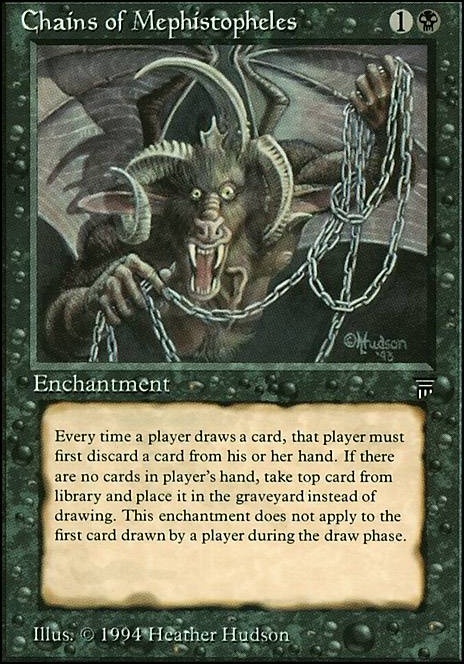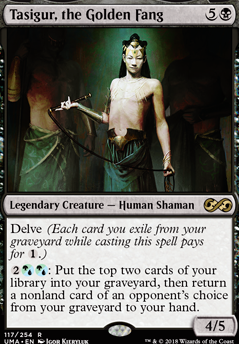With multiple methods to cheat Razaketh into play, either Reanimation or Eldritch Evolution, we can use him as an engine to push for an immediate win.
Once we have cheated Razaketh, the Foulblooded into play, we are just getting started. The big question is where do we go from from here.
The most important thing in winning with Razaketh is to plan in advance: How many resouces do I have? What possibilities for disruption are on the board? What mana do my opponents have at their disposal and what might be in their hands?
What to get from your Deck
Razaketh himself needs two resources: Life and creatures. The cards we usually aim at to go off are Isochron Scepter, Dramatic Reversal, and three available Mana in non land mana sources; two of them are required to reactivate Isochron Scepter and one to go infinite. If the only colored mana you can produce with these mana rocks black, generate a substantial amount of mana, then use it to recast Tasigur, then sac him to Razaketh and grab another mana rock that produces blue or green mana for the Tasigur loops.
This usually comes down to four cards we get from our deck: Isochron Scepter, Dramatic Reversal, Mana Crypt and a coloured mana rock such as Mox Opal/Mox Diamond. Often times we already have some of these in play and can assemble this around what we already have in play.
What do do if we don't have any other creatures in play - Life / Death
The full process listed above would usually require us to sacrifice four creatures to Razaketh and pay eight life. While the life cost is often negligible, it is rare to have four creatures out. Luckily, we can solve this problem with card:Life//Death. This card can turn all our lands into Razaketh fodder and solve the creature problem with ease (usually leaving some lands behind in case we need protection or removal).
The primary line with Razaketh
We start with the first bit. Cheat Razaketh, the Foulblooded into play, sac a creature (Keep in mind: Our commander can be delved in easily in case we have no other creature to sac), grab card:Life//Death from our library, cast Life, tap then sacrifice four lands to get the winning pieces listed above. This win comes at the cost of one green mana and ten life once Razaketh is on the battlefield.
In case you need coloured mana from Mox Diamond you need to plan in another land and two life to grab another land to hand.
Special cases and how to solve them
The following problems can occur in the process:
An essential card is in exile
There are two options here:
-
A part of the Dramatic Scepter combo is in exile? In this case you do not go for a Razaketh without having access to Riftsweeper. If there are multiple pieces of the combo in exile, you can bounce Riftsweeper and recast him to get the remaining missing pieces. You can also reconsider grabbing your alternative Evolution target in this situation.
-
A card you need to loop is in exile? Don't despair, the elegant part of most of these loops is that they have built in back ups. While you usually loop Beast Within and Reality Shift, you can also exile their libraries with Praetor's Grasp, though this is at sorcery speed only. If you also happen to run Aetherflux Reservoir, you can use it as your wincondition instead. Put it into play then build up life total through Isochron Scepter activataions and casting Dramatic Reversal to your hearts content.
You don't have enough Life left to go for a win
This is a tricky situation. Usually at this stage of the game you are under significant pressure and are needing resources to either stabalize or have already stabalized and are at a very low life total. At this stage you have two primary options for your Eldritch Evolution.
-
Evolve Tasigur into card:Nezahl, the primal Tide instead of Razaketh. This will work to provide you a steady source of card advantage and can fuel the rest of the game. From here you start working on a combat damage win or start assembling the combo pieces without Razaketh.
-
Evolve Tasigur into Razaketh and grab an Aetherflux Reservoir. You are then looking at using your storm and the Reservoir to gain you enough life to continue the Razaketh line. This is a more resource intensive line and leaves less mana available to you for protection.
Take a look at the boardstate and decide which route you prefer. If you have judged the moment correctly, the second option can be just as potent as a normal Razaketh line.
The Stax and Interaction to look out for.
Luckily both Tasigur and Razaketh have the same vulerabilities - Cursed Totem/Linvala, Keeper of Silence. However Razaketh has one additional vulnerability (though it is so rare it is almost irrelevant) Angel of Jubilation.
For almost any other Stax piece you can use Razaketh to search your deck for a way to nullify the card and move on with your win.
The last word of caution to look out for is Trickbind. It locks you out of activating what ever permanent is countered for a whole turn. The upside to this is that regardless of where you are in the process, Trickbind would stop you. Trickbind on Razaketh, on Isochron Scepter, or on Tasigur would stop you for the whole turn. Your opponent will choose the most opportune moment for them, usually the most exposed moment for you.
If your opponents are familiar with the deck it will be at one of a few different points in the chain.
-
Your first sacrifice to Razaketh.
-
Your first sacrifice after casting Life / Death.
-
The imprint trigger on Isochron Scepter.
-
The First activation of Isochron Scepter.
-
The First actication of Tasigur after generating unbounded mana.
If you fear Trickbind, there are a few things you can do to protect yourself yourself. First is to prepare by having additional creatures in play before tutoring with Razaketh for the first time. You do have the ability to bolster yourself with Razaketh activations. If you hold priority and sacrifice multiple creatures all in a row, your opponents cannot respond until you have passed priority. They can still Trickbind Razaketh at this point, countering a single activation and preventing you from activating it again for the rest of the turn, but you will still have multiple other Razaketh activations on the stack.
At this point your opponents may not Trickbind Razaketh and move on to trickbind the Isochron Scepter Imprint trigger, you can work around this with a Copy Artifact in your library, an additional sacrifice and some more mana can give you a second Scepter, this one has not been trickbound and can be imprinted with Dramatic Reversal.
If they counter the first spell activation from Isochron Scepter, you are in a rough spot. You have already exiled Dramatic Reversal. There are lines to get your Dramatic Reversal back but they are most likely too expensive for you at this point. You are looking at working to protect your Scepter until your next chance to untap it. You are pretty out on a limb here. Good luck.
If they have waited to the point of you activating Tasigur for the first time to Trickbind Tasigur, simply sacrifice him to Razaketh, recast him and keep going.







